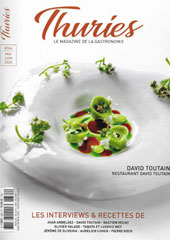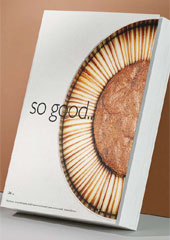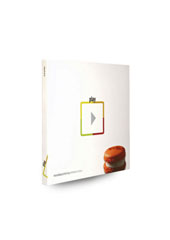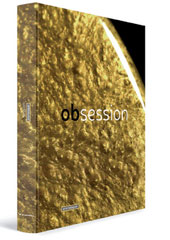Presentations
L' Astrance
The 'Non Menu' Restaurant
Presentations - Restaurants
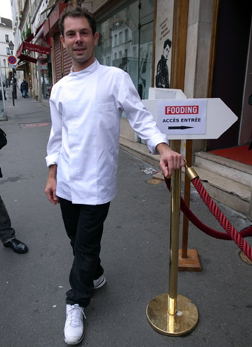
Gastronomes here were taken aback when L' Astrance won three stars in the
Michelin guide, because it did not meet the usual three-star requirements at all.
L'Astrance seats only 25 guests, there's no silverware, decor is minimal,
the size of the kitchen is that of a Manhattan condo and there's not even a menu!
This year L' Astrance leveled up to the 11th position of the 50 World's Best
Restaurants in St Pellegrino's list and here is its story...
In October 2000, Pascal Barbot and Christophe Rohat, formerly sous chef and maitre d'hotel at l'Arpege respectively, opened their own restaurant.
With the aid of bank loans borrowed by the pair after Rohat won a prestigious Heidsieck Monopole prize for best restaurant business plan, the two bought a
closed-down bistro in a sleepy street in the 16th. They were an instant success.
Leading Parisian critic, Benedict Beauge, even commented that their new venture was "the most important gastronomic event" of the time.
Such coverage, as well as Passard's personal mailing list of five hundred loyal clients, ensured that from then on, l'Astrance would be one of the city's most sought-after tables.
Within only months (five) of setting up, Michelin awarded them their first star (2001), though they did have to wait a little longer for the second (2005)
and then third (2007). With this dramatic, rapid rise came controversy. L'Astrance, the smallest and most casual of Paris' three stars, is different.
First, there is no traditional menu.
Instead, diners choose how many courses they want and the kitchen chooses what to prepare - a scenario that Joel Robuchon
once fantasised about, but did not think possible.
Secondly, classic French cuisine and ingredients i.e. heavy saucing, cream, butter have all been abandoned in favour of a healthier, lighter cooking with a
decidedly Oriental leaning. Going against the grain however gained them their detractors, some of whom even claimed that the
restaurant' third etoile was political: at the time, there was a cloud around Michelin concerning the stress, emotional and financial,
faced by chefs desperate to cling to their stars and they alleged that informal l’Astrance’s third was the guide's attempt to dispel this.
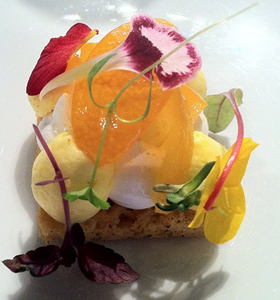 |
Whether the accusation is true or not, not many would argue that the food here is not of the highest standard and that Barbot is not a talented chef.
The pair also seem happy regardless; with a team of half a dozen in the FOH, the same in the kitchen and a self-imposed fifty-covers-a-day limit
"things are perfect now. We work hard for four days [and] have the weekend to relax and be with our families", to quote Rohat...
Barbot, who spent his childhood harvesting vegetables in the family garden and watching his parents cook, claims he knew from the age of seven that he
wanted to be a chef. With this in mind, he attended cooking school before stints at Maxim's, Clave (1*) and Troisgros (3*).
He then moved to London to work under Joel Antunes at Les Saveurs (1990-92) before completing his military service, which had him cooking for the admiral
of the French Pacific fleet and island hopping between New Caledonia, New Zealand, Tonga and Fiji. He returned to France in 1993 and joined l’Arpege (3*)
where he met Rohat. Here, "five magical years liberated [him] and gave [him] the desire, with Christophe, to rehabilitate a certain idea of the restaurant that,
for [them], must be a place of interchange, coherence and complicity".
Prior to realising this "idea" though, he went to Ampersand in Sydney for a year (1998-99) and, on his second return, he and Rohat had a very brief spell at historic Laperouse.
Within months, however, they were gone and l’Astrance was born.
The astrance title is not, of course, without a story of its own.
Parisian restaurateurs share a belief that having a name starting with A is advantageous
as this places them at the beginning of dining guides thus improving their chances of customers calling them first.
 |
Barbot and Rohat think the same way, but were at a complete loss as to which A they would use. This was until Rohat, one day hiking in the Auvergne,
came across a wild, ironically inedible, star-like flower called Grand Astrance. He immediately phoned his partner...
Barbot, who includes Passard, Gagnaire, Bras, Veyrat and Wakuda as inspirations, is somewhat of a maverick in the kitchen. Rarely does he use measures or weights;
his favourite tool is a mortar and pestle he brought back from Thailand with which he loves to make curry paste; just hours after dinner service, he can be found
strolling the city’s food markets, like that at Rungis or Iena; and he is even working with molecular gastronomy scientists.
He is impulsive - last-minute weekend trips to Sweden, Morocco and Italy are not unusual - and has an adventurous spirit - James Cook is his hero.
In contradiction to his Vichois heritage, his cooking principles are humble, "one can do as many things with citrus as with a truffle for example; for me, one and
the other deserve the same attention". He marries all these influences together to create contemporary, dynamic and exciting food.
La carte covers merely two pages. One side offers three choices: menu Dejeuner (three courses), menu Hiver (five) and menu Astrance (seven) - each with or without wine pairing.
An inventory of ingredients on the other side intimates at what may come.
One simply must decide how many dishes they want and let the staff know if there is anything on the list they cannot or will not eat. In fact Pascal Barbot just follows the
stream of his inspiration and offers a "menu surprise" every day.
So you never know in advance what you are going to eat...
 |


